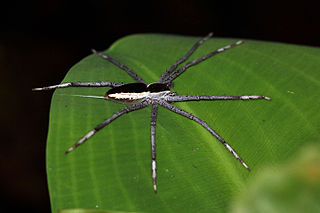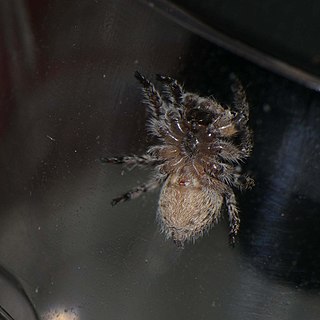
Nursery web spiders (Pisauridae) are a family of araneomorph spiders first described by Eugène Simon in 1890. Females of the family are known for building special nursery webs. When their eggs are about to hatch, a female spider builds a tent-like web, places her egg sac inside, and stands guard outside, hence the family's common name. Like wolf spiders, however, nursery web spiders are roaming hunters that do not use webs for catching prey.

Brachypelma smithi is a species of spider in the family Theraphosidae (tarantulas) native to Mexico. It has been confused with Brachypelma hamorii; both have been called Mexican redknee tarantulas. Mexican redknee tarantulas are a popular choice as pets among tarantula keepers. Many earlier sources referring to B. smithi either relate to B. hamorii or do not distinguish between the two species. B. smithi is a terrestrial tarantula native to Pacific coast of the Mexican state of Guerrero.

Neischnocolus is a genus of spiders in the family Theraphosidae. It was first described in 1925 by Petrunkevitch. The genus Ami was separately described in 2008, but was later discovered to be a junior synonym of Neischnocolus. Species are native to Central America and northern South America.

Zygoballus sexpunctatus is a species of jumping spider which occurs in the southeastern United States where it can be found in a variety of grassy habitats. Adult spiders measure between 3 and 4.5 mm in length. The cephalothorax and abdomen are bronze to black in color, with reddish brown or yellowish legs. The male has distinctive enlarged chelicerae and front femora. Like many jumping spiders, Z. sexpunctatus males exhibit ritualized courtship and agonistic behavior.

Progradungula otwayensis, commonly known as the odd-clawed spider, is a species of cribellate spider endemic to the Great Otway National Park of Victoria, Australia. It is one of only two species in the gradungulid genus Progradungula.

Padava laminata is a species of araneomorph spider in the family Titanoecidae. It is widely distributed from East Africa through China to New Guinea and the Marquesas Islands.
Entypesa is a genus of African mygalomorph spiders in the family Entypesidae. It was first described by Eugène Louis Simon in 1902. Originally placed with the curtain-web spiders, it was transferred to the funnel-web trapdoor spiders in 1985, then to the Entypesidae in 2020. It is a senior synonym of Pseudohermacha.

Evarcha russellsmithi is a species of jumping spider in the genus Evarcha that lives in Ethiopia. The species was first described in 2008 by Wanda Wesołowska and Beata Tomasiewicz. The spider is small to medium-sized, with a cephalothorax measuring typically 2.2 mm (0.09 in) long and an abdomen 1.8 mm (0.07 in) long. The carapace is yellowish with dark rings around the spider's eyes. The abdomen is brown with an indistinct pattern of spots and lines. The legs are generally brown. The copulatory organs are distinctive. The male has a projection, or apophysis, from the palpal tibia that has a series of tooth-like features, and a very short embolus that is attached to another very small apophysis. The female has multi-chambered spermathecae and distinctive accessory glands.

Pellenes striolatus is a species of jumping spider in the genus Pellenes that lives on Socotra Island, Yemen. It was first described in 2002 by Wanda Wesołowska and Antonius van Harten. The spider is smaller than many in the genus, with a carapace that measures typically 1.4 mm (0.06 in) in length and an abdomen that is between 1.3 and 2 mm long. The female has a larger abdomen than the male. Both are generally very dark, nearly black, and have a distinctive white pattern on the abdomen. The pattern consists of a central white stripe that is flanked by white diagonal lines, and is recalled in the species name, which can be translated "thinly streaked". The spider has copulatory organs that are similar to other species in the genus. The female has a shallow pocket in the middle of its epigyne and the male has a thick embolus.

Evarcha arabica is a species of jumping spider in the genus Evarcha that lives in Yemen. The species was first described in 2007 by Wanda Wesołowska and Antonius van Harten. The spider is small, with a carapace that measures between 2.1 and 2.7 mm long and an abdomen that is between 1.8 and 3.2 mm long. The female is generally larger and lighter than the male. The spider's eye field is darker. The top of the male abdomen is blackish-brown with a pattern of white dots and a large yellowish-orange belt. The top of the female abdomen has similar white dots but is mainly yellow with small darker dots. The male's legs are brown and yellow while the female's are orange to yellow. It has distinctive copulatory organs. The female has accessory glands near the copulatory openings and simple bean-like spermathecae. The male has a thin embolus and a tibial apophysis that has a forked tip.

Euophrys kawkaban is a species of jumping spider in the genus Euophrys that is endemic to Yemen. The species was first described in 2007 by Wanda Wesołowska and Antonius van Harten. It is a very small spider, with a body that consists of a carapace, the hard upper part of the cephalothorax, that is typically 1.7 mm (0.07 in) long and 1.3 mm (0.05 in) wide and an abdomen that is typically 1.5 mm (0.06 in) long and 1.1 mm (0.04 in) wide. The carapace is yellowish, marked with a pattern of brown wedges, with a dark brown eye field. The underside of the cephalothorax, or sternum, is yellowish-brown. The abdomen has a pattern of yellowish-white and brownish-black spots that, at times, look like a series of waves. The spider's clypeus is unusual, being yellowish-brown with a covering of white hairs, which clearly differentiates the species from the related Euophrys flavoater. The male's copulatory organs, including its long and thin embolus, also helps distinguish the species. The female has not been described.

Langelurillus krugeri is a species of jumping spider in the genus Langelurillus that lives in South Africa. The species was first described in 2013 by Wanda Wesołowska and Charles Haddad. The spider is small with a brownish-grey abdomen typically 2.9 mm (0.11 in) long and a black carapace typically 1.9 mm (0.075 in) long. The species is named after Paul Kruger, who had been State President of the South African Republic. The first example was found in the Kruger National Park. The female can be distinguished from other spiders in the genus, particularly Langelurillus primus', in the design of its copulatory organs. The male has not been described.
Chrysilla guineensis is a species of jumping spider. It is endemic to Guinea. It was described in 2013 based on specimens collected from the Nimba Mountains.

Euophrys cochlea is a species of jumping spider in the genus Euophrys that is endemic to South Africa. The species was first described in 2014 by Wanda Wesołowska, Galina Azarkina and Anthony Russell-Smith. It is a medium-sized brown spider, with a body that consists of a cephalothorax that is between 1.7 and 2.4 mm long and an abdomen between 1.7 and 2.9 mm (0.11 in) long. The cephalothorax has a dark brown carapace, or topside. The spider's eye field is darker, with black rings around the eyes but marked with a white patch. The female has a yellowish-brown abdomen while the male is a darker brown. While the female has light brown to yellow legs, the male's legs whitish-yellow or yellowish-orange. The spider is most easily differentiated from others species in the genus by its screw-like embolus, part of the male's copulatory organs. This is recalled in the species name, the Latin word for screw.

Euophrys meridionalis is a species of jumping spider in the genus Euophrys that is known as the Royal Natal Euophrys Jumping Spider. Endemic to South Africa, the species was first described in 2014 by Wanda Wesołowska, Galina Azarkina and Anthony Russell-Smith. It is a very small spider, smaller than most in the genus, with a body that consists of a cephalothorax that measures between 1 and 1.2 mm long and a abdomen that is between 1 and 1.3 mm (0.05 in) long. The carapace, the topside of the cephalothorax, is dark brown and the underside of the cephalothorax, or sternum, is brownish. The pattern on the abdomen differs between the female and the male. The female has a dark surface marked with light patches, including a series of chevrons in the middle. The male has a plain brown scutum in the top but a yellowish-grey or blackish underside with a pattern light dotted lines. The male has generally brown legs, apart from the front pair, which are black and yellow, while the female's legs are all yellowish with some brown parts. The male has a longer embolus than Euophrys falciger, but it otherwise similar, apart from its size.

Tliltocatl verdezi is a species of spiders in the family Theraphosidae (tarantulas), found in Mexico.
Exechocentrus lancearius is a species of spider in the orb-weaver spider family Araneidae, found only in Madagascar. It was initially described from a partial specimen of an adult female. The first description of a complete specimen and its prey-catching behaviour was published in 2012. E. lancearius is a bolas spider. Rather than using a web, adult females catch their prey by using a line with one or two sticky drops which they swing.

Pasilobus hupingensis is a species of spider in the orb-weaver spider family Araneidae, found in China and Japan. Females of the genus Pasilobus construct "spanning-thread webs" with only two sectors, making them appear triangular. Widely spaced threads with sticky drops span the three radii of these webs. One end is attached in such a way that it readily breaks free. When a prey item is caught on one of these threads, the line parts at this end and the prey hangs from the web until it is hauled up by the spider.

Sahastata wesolowskae is a species of crevice weaver in the genus Sahastata that lives in Oman. It was first described in 2020 by Ivan Magalhaes, Mark Stockmann, Yuri Marusik and Sergei Zonstein. The spider is small, with a carapace that is between 1.67 and 3.36 mm long and an abdomen that is between 3.73 and 4.94 mm long. The female is larger than the male, darker in color and has a more rounded abdomen. Both have a V-shaped pattern towards the middle of the carapace, but it is clearer on the female. The male has a long and slightly bent embolus. The female has an endogyne with distinctive spermathecae. It is these copulatory organs that most clearly differentiate the species from other spiders in the genus.















